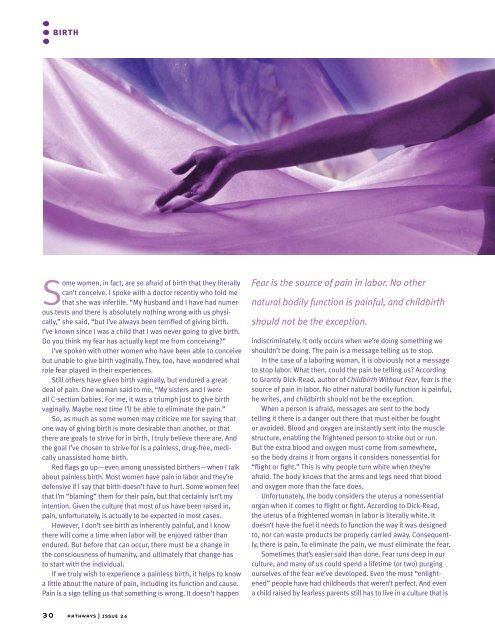Organic Foods: Know the Facts - Dr. Trent Maly
Organic Foods: Know the Facts - Dr. Trent Maly
Organic Foods: Know the Facts - Dr. Trent Maly
You also want an ePaper? Increase the reach of your titles
YUMPU automatically turns print PDFs into web optimized ePapers that Google loves.
irth<br />
Some women, in fact, are so afraid of birth that <strong>the</strong>y literally<br />
can’t conceive. I spoke with a doctor recently who told me<br />
that she was infertile. “My husband and I have had numerous<br />
tests and <strong>the</strong>re is absolutely nothing wrong with us physically,”<br />
she said, “but I’ve always been terrified of giving birth.<br />
I’ve known since I was a child that I was never going to give birth.<br />
Do you think my fear has actually kept me from conceiving?”<br />
I’ve spoken with o<strong>the</strong>r women who have been able to conceive<br />
but unable to give birth vaginally. They, too, have wondered what<br />
role fear played in <strong>the</strong>ir experiences.<br />
Still o<strong>the</strong>rs have given birth vaginally, but endured a great<br />
deal of pain. One woman said to me, “My sisters and I were<br />
all C-section babies. For me, it was a triumph just to give birth<br />
vaginally. Maybe next time I’ll be able to eliminate <strong>the</strong> pain.”<br />
So, as much as some women may criticize me for saying that<br />
one way of giving birth is more desirable than ano<strong>the</strong>r, or that<br />
<strong>the</strong>re are goals to strive for in birth, I truly believe <strong>the</strong>re are. And<br />
<strong>the</strong> goal I’ve chosen to strive for is a painless, drug-free, medically<br />
unassisted home birth.<br />
Red flags go up—even among unassisted bir<strong>the</strong>rs—when I talk<br />
about painless birth. Most women have pain in labor and <strong>the</strong>y’re<br />
defensive if I say that birth doesn’t have to hurt. Some women feel<br />
that I’m “blaming” <strong>the</strong>m for <strong>the</strong>ir pain, but that certainly isn’t my<br />
intention. Given <strong>the</strong> culture that most of us have been raised in,<br />
pain, unfortunately, is actually to be expected in most cases.<br />
However, I don’t see birth as inherently painful, and I know<br />
<strong>the</strong>re will come a time when labor will be enjoyed ra<strong>the</strong>r than<br />
endured. But before that can occur, <strong>the</strong>re must be a change in<br />
<strong>the</strong> consciousness of humanity, and ultimately that change has<br />
to start with <strong>the</strong> individual.<br />
If we truly wish to experience a painless birth, it helps to know<br />
a little about <strong>the</strong> nature of pain, including its function and cause.<br />
Pain is a sign telling us that something is wrong. It doesn’t happen<br />
30 pathways | issue 26<br />
Fear is <strong>the</strong> source of pain in labor. No o<strong>the</strong>r<br />
natural bodily function is painful, and childbirth<br />
should not be <strong>the</strong> exception.<br />
indiscriminately. It only occurs when we’re doing something we<br />
shouldn’t be doing. The pain is a message telling us to stop.<br />
In <strong>the</strong> case of a laboring woman, it is obviously not a message<br />
to stop labor. What <strong>the</strong>n, could <strong>the</strong> pain be telling us? According<br />
to Grantly Dick-Read, author of Childbirth Without Fear, fear is <strong>the</strong><br />
source of pain in labor. No o<strong>the</strong>r natural bodily function is painful,<br />
he writes, and childbirth should not be <strong>the</strong> exception.<br />
When a person is afraid, messages are sent to <strong>the</strong> body<br />
telling it <strong>the</strong>re is a danger out <strong>the</strong>re that must ei<strong>the</strong>r be fought<br />
or avoided. Blood and oxygen are instantly sent into <strong>the</strong> muscle<br />
structure, enabling <strong>the</strong> frightened person to strike out or run.<br />
But <strong>the</strong> extra blood and oxygen must come from somewhere,<br />
so <strong>the</strong> body drains it from organs it considers nonessential for<br />
“flight or fight.” This is why people turn white when <strong>the</strong>y’re<br />
afraid. The body knows that <strong>the</strong> arms and legs need that blood<br />
and oxygen more than <strong>the</strong> face does.<br />
Unfortunately, <strong>the</strong> body considers <strong>the</strong> uterus a nonessential<br />
organ when it comes to flight or fight. According to Dick-Read,<br />
<strong>the</strong> uterus of a frightened woman in labor is literally white. It<br />
doesn’t have <strong>the</strong> fuel it needs to function <strong>the</strong> way it was designed<br />
to, nor can waste products be properly carried away. Consequently,<br />
<strong>the</strong>re is pain. To eliminate <strong>the</strong> pain, we must eliminate <strong>the</strong> fear.<br />
Sometimes that’s easier said than done. Fear runs deep in our<br />
culture, and many of us could spend a lifetime (or two) purging<br />
ourselves of <strong>the</strong> fear we’ve developed. Even <strong>the</strong> most “enlightened”<br />
people have had childhoods that weren’t perfect. And even<br />
a child raised by fearless parents still has to live in a culture that is


